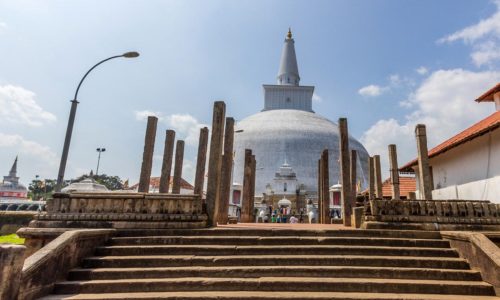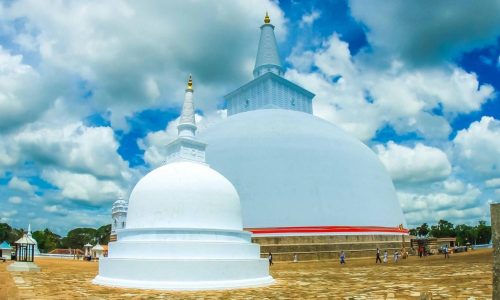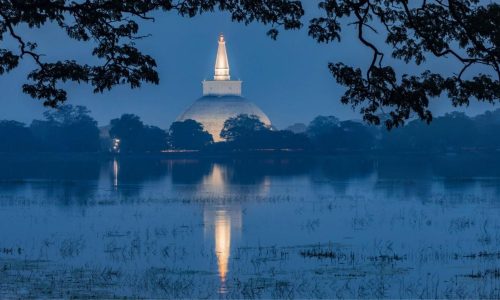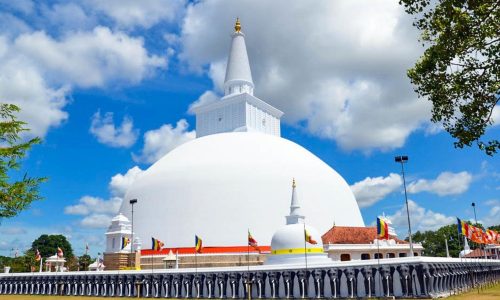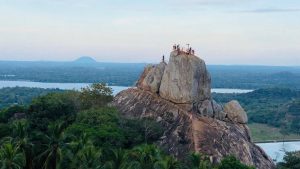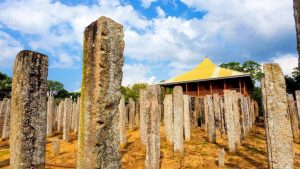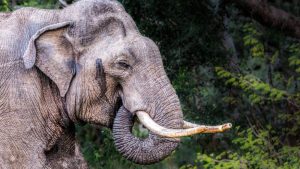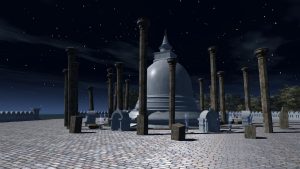The Ruwanweli Maha Seya, even the Mahathupa, is a stupa in Anuradhapura, Sri Lanka. Two quarts or one Dona of the Buddha’s relics are glorified in the stupa, creating the most extensive collection of his relics anywhere. Sinhalese King Dutugemunu built it in c. 140 B.C. He defeated a Chola king named Elara in a war and became king. It is known as Swarnamali Seya, Svaṇṇamāli, Mahaceti, and Rathnamali Seya.
It is one of the “Solosmasthana” and the “Atamasthana.” The stupa is one of the world’s most towering archaic monuments, standing at 103 m (338 ft) and with a perimeter of 290 m (951 ft). Many kings have renovated this 55m (180 ft ) tall stupa. The Kaunghmudaw Pagoda in Sagaing, Myanmar, was modeled after this stupa. The Mahavamsa contains a detailed account of the construction and the opening ceremony of the stupa. By the 19th century, the stupa had gone entirely to the jungle. After a bhikkhu’s fundraising efforts, it has renovated in the early 20th century. The Ruwanweli Seya Restoration Society has set up by philanthropist Hendrick Appuhamy, who presented Rs 20 million (1912 ). Accommodated for inflation in 2021, it is worth 611 million U.S. Dollars for the restoration works. Established the foundation in 1902, and the final crowning of the stupa took place on 17 June 1940.
In the Mahavamsa, Ashoka of the Maurya dynasty determines not to recover Buddha relics retaining Nagas at Ramagrama. Said that on his deathbed, Buddha articulated an augury that of the eight Donas of his body relics, one would be rever by the Koliyas of Ramagrama. The has-beens would belong to the Nagas until being glorified in Sri Lanka. Ashoka is revealed more prophecy by arhats, who speak of the forthcoming enshrinement of these relics by king Dutthagamini.
King Dutthagamini then acquired the Buddha’s relics from the Sangha upon his authority in a coffin. He exited from the golden pavilion amid various offerings and honors created by gods and “Brahmas.” He circumambulated the relic-chamber three times, joined it from the east, and when laid the relic casket on a silver couch, one “koṭi” worth that arranged on the north side. An image of Buddha was then, According to the Buddha’s determination, created in the lion’s reclining posture (“Sihaseyya”), and all the relics had enshrined within that image. When the glorifying of the antiques in the Great Stūpa Ruvanveli has completed, the two novices, Uttara and Sumana, closed the relic chamber with the stone blocks that had previously been hidden and used as a lid.
In the Thupavamsa, countless kinds of beings attended the enshrinement of the relics into the Mahathupa, including the Naga king Mahakala who guarded them. The has-beens place atop a golden throne crafted by Visvakarman, the divine artificer, the throne brought by Indra. Brahma offers his invisible sovereignty umbrella, with the king Dutthagamani presenting his own. The arhat Indagutta makes a metal canopy over the universe so that Mara will not interfere as monks chant the Sutta Pitaka. Dutthagamani ceremoniously enters with the jar atop his head. Still, as he is about to place the pot on the golden throne, the relics increase into the air and form Buddha, per the 32 significant signs and 80 lesser signs of a great man. In this form, he achieves the twin miracle of fire and water, fulfilling the fifth of his death bed solutions. One hundred and twenty million gods and humans gain Arhatship from this experience. The relics were replaced in the urn, laid to rest, and the chamber sealed with forty-meter stone slabs.
“The relic-chamber shall not stagger even by an earthquake; flowers such as jasmine that presented on that day shall not wither till the end of Buddha Gotama’s Dispensation; the lights that kindled with ghee-oil shall not extinguish; the clay that combined with perfume and sandalwood shall not dry; even a single scratch shall not appear within the relic-chamber; stains shall not occur in any of the golden goods that offered.’ All this appeared by the determination-power of all Arahants present. They also determined that inimical persons should not even be able to see the relic chamber. Furthermore, by command of king Dutugemunu, the people of Srī Lanka glorified, along with multiple other objects such as golden and silver caskets, thousand more of the Buddha’s relics over the relic-chamber.”The stupa has damaged during the Chola conquest of Anuradhapura. Still, it has renovated during the reign of Parakramabahu I (1153–1187), who invaded South India, capturing large parts of Tamil Nadu Parakramabahu used the captured Tamils for the work of renovation.

